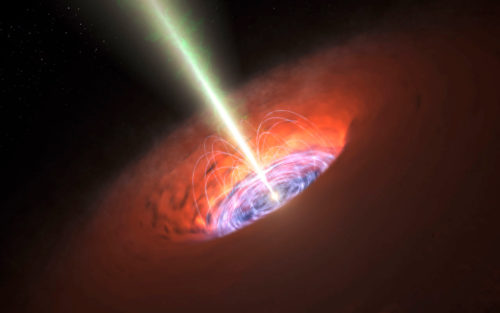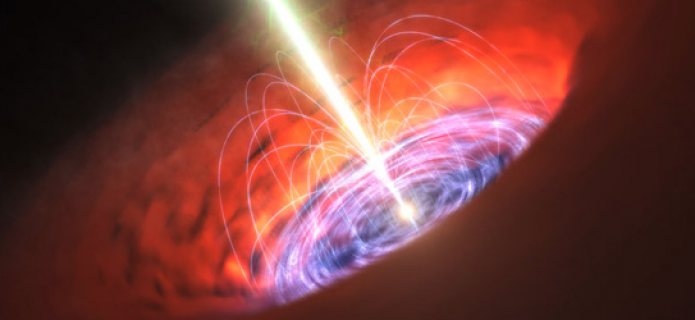ALMA Reveals Intense Magnetic Field Close to Supermassive Black Hole
The Atacama Large Millimeter/submillimeter Array (ALMA) has revealed an extremely powerful magnetic field, beyond anything previously detected in the core of a galaxy, very close to the event horizon of a supermassive black hole. This new observation helps astronomers to understand the structure and formation of these massive inhabitants of the centres of galaxies, and the twin high-speed jets of plasma they frequently eject from their poles. The results appear in the 17 April 2015 issue of the journal Science.
Supermassive black holes, often with masses billions of times that of the Sun, are located at the heart of almost all galaxies in the Universe. These black holes can accrete huge amounts of matter in the form of a surrounding disc. While most of this matter is fed into the black hole, some can escape moments before capture and be flung out into space at close to the speed of light as part of a jet of plasma. How this happens is not well understood, although it is thought that strong magnetic fields, acting very close to the event horizon, play a crucial part in this process, helping the matter to escape from the gaping jaws of darkness.

This artist's impression shows the surroundings of a supermassive black hole, typical of that found at the heart of many galaxies. The black hole itself is surrounded by a brilliant accretion disc of very hot, infalling material and, further out, a dusty torus. There are also often high-speed jets of material ejected at the black hole's poles that can extend huge distances into space. Observations with ALMA have detected a very strong magnetic field close to the black hole at the base of the jets and this is probably involved in jet production and collimation.
Up to now only weak magnetic fields far from black holes — several light-years away — had been probed [1]. In this study, however, astronomers from Chalmers University of Technology and Onsala Space Observatory in Sweden have now used ALMA to detect signals directly related to a strong magnetic field very close to the event horizon of the supermassive black hole in a distant galaxy named PKS 1830-211. This magnetic field is located precisely at the place where matter is suddenly boosted away from the black hole in the form of a jet.
The team measured the strength of the magnetic field by studying the way in which light was polarised, as it moved away from the black hole.
"Polarisation is an important property of light and is much used in daily life, for example in sun glasses or 3D glasses at the cinema,"says Ivan Marti-Vidal, lead author of this work. "When produced naturally, polarisation can be used to measure magnetic fields, since light changes its polarisation when it travels through a magnetised medium. In this case, the light that we detected with ALMA had been travelling through material very close to the black hole, a place full of highly magnetised plasma."
This artist's impression shows the surroundings of a supermassive black hole, typical of that found at the heart of many galaxies. The black hole itself is surrounded by a brilliant accretion disc of very hot, infalling material and, further out, a dusty torus. There are also often high-speed jets of material ejected at the black hole's poles that can extend huge distances into space. Observations with ALMA have detected a very strong magnetic field close to the black hole at the base of the jets and this is probably involved in jet production and collimation.
The astronomers applied a new analysis technique that they had developed to the ALMA data and found that the direction of polarisation of the radiation coming from the centre of PKS 1830-211 had rotated [2]. These are the shortest wavelengths ever used in this kind of study, which allow the regions very close to the central black hole to be probed [3].
"We have found clear signals of polarisation rotation that are hundreds of times higher than the highest ever found in the Universe," says Sebastien Muller, co-author of the paper. "Our discovery is a giant leap in terms of observing frequency, thanks to the use of ALMA, and in terms of distance to the black hole where the magnetic field has been probed — of the order of only a few light-days from the event horizon. These results, and future studies, will help us understand what is really going on in the immediate vicinity of supermassive black holes."
Notes
[1] Much weaker magnetic fields have been detected in the vicinity of the relatively inactive supermassive black hole at the centre of the Milky Way. Recent observations have also revealed weak magnetic fields in the active galaxy NGC 1275, which were detected at millimetre wavelengths.
[2] Magnetic fields introduce Faraday rotation, which makes the polarisation rotate in different ways at different wavelengths. The way in which this rotation depends on the wavelength tells us about the magnetic field in the region.
[3] The ALMA observations were at an effective wavelength of about 0.3 millimetres, earlier investigations were at much longer radio wavelengths. Only light of millimetre wavelengths can escape from the region very close to the black hole, longer wavelength radiation is absorbed.
More Information
This research was presented in a paper entitled "A strong magnetic field in the jet base of a supermassive black hole" to appear in Science on 16 April 2015.
The team is composed of I. Martí-Vidal (Department of Earth and Space Sciences, Chalmers University of Technology, Onsala Space Observatory, Onsala, Sweden), S. Muller (Onsala Space Observatory), W. Vlemmings (Onsala Space Observatory), C. Horellou (Onsala Space Observatory), S. Aalto (Onsala Space Observatory).
The Atacama Large Millimeter/submillimeter Array (ALMA), an international astronomy facility, is a partnership of the European Organisation for Astronomical Research in the Southern Hemisphere (ESO), the U.S. National Science Foundation (NSF) and the National Institutes of Natural Sciences (NINS) of Japan in cooperation with the Republic of Chile. ALMA is funded by ESO on behalf of its Member States, by NSF in cooperation with the National Research Council of Canada (NRC) and the Ministry of Science and Technology (MOST) in Taiwan and by NINS in cooperation with the Academia Sinica (AS) in Taiwan and the Korea Astronomy and Space Science Institute (KASI).
ALMA construction and operations are led by ESO on behalf of its Member States; by the National Radio Astronomy Observatory (NRAO), managed by Associated Universities, Inc. (AUI), on behalf of North America; and by the National Astronomical Observatory of Japan (NAOJ) on behalf of East Asia. The Joint ALMA Observatory (JAO) provides the unified leadership and management of the construction, commissioning and operation of ALMA.
Contact:
Valeria Foncea
Education and Public Outreach Officer
Joint ALMA Observatory
Santiago, Chile
Tel: +56 2 467 6258
Cell: +56 9 75871963
Email: [email protected]
Richard Hook
Public Information Officer, ESO
Garching bei München, Germany
Tel: +49 89 3200 6655
Cell: +49 151 1537 3591
Email: [email protected]
Charles E. Blue
Public Information Officer
National Radio Astronomy Observatory
Charlottesville, Virginia, USA
Tel: +1 434 296 0314
Cell: +1 434.242.9559
E-mail: [email protected]
Masaaki Hiramatsu
Education and Public Outreach Officer, NAOJ Chile
Observatory Tokyo, Japan
Tel: +81 422 34 3630
E-mail: [email protected]

